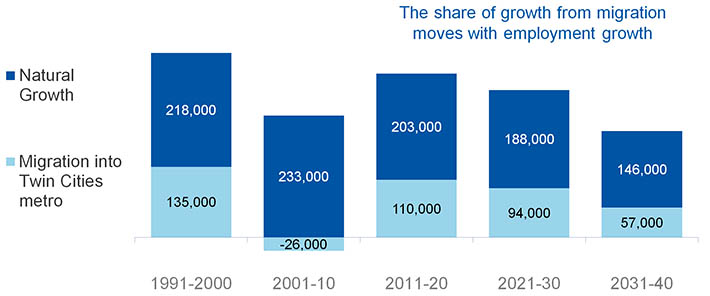The Twin Cities region will gain 803,000 residents between 2010 and 2040, bringing the region’s population to 3,653,000, according to updated regional forecasts published by the Metropolitan Council in November. The estimated 2018 population of the seven-county metro area is 3,113,000.
Over the same years, the metro area will add 472,000 jobs, reaching more than two million jobs by 2040. Half of those jobs have already been added during 2010-2019, meaning job growth is expected to slow in the next two decades as the regional and national economies struggle with long-term workforce shortages and the replacement of baby boom generation workers.

The aging of baby boomers will lead to a rapid doubling of the number of older households.
“Older adults’ preferences and housing needs will reshape the region’s housing market,” said Todd Graham, Council researcher. “We are already seeing evidence of that in new and proposed senior housing projects around the region.”
Reduced household formation and depressed housing production
 At the same time, the phenomena of delayed household formation and “doubling up” have boosted household sizes and slowed household formation rates since the Great Recession. Council researchers have revised household growth forecasts downward from the 2017 forecast of 419,000 new households over three decades. The region is now projected to gain 329,000 households between 2010 and 2040.
At the same time, the phenomena of delayed household formation and “doubling up” have boosted household sizes and slowed household formation rates since the Great Recession. Council researchers have revised household growth forecasts downward from the 2017 forecast of 419,000 new households over three decades. The region is now projected to gain 329,000 households between 2010 and 2040.
“Household income growth lags far behind housing prices growth in the region,” Graham said. “This discourages and blocks millennials from getting their own place, forming their own households, and having children. And housing production has suffered because of the slack demand.”
If household formation rates had remained at the pre-2010 level, the region would have gained 120,000 households between 2010 and 2018. The actual, observed growth was 96,000 households. At the same time, builders added only 76,000 housing units between 2010 and 2018.
More people of color, more older people
A continuing trend is the Twin Cities metro area is becoming more racially and ethnically diverse. The population of color will more than double from 2010 to 2040, growing from 767,000 to 1,453,000, and comprise a greater share of our region’s population, from 24% in 2010 to 40% in 2040.
While every age cohort will grow, none will grow as fast as the 65 and older population. The region’s older adult population will increase 148% between 2010 and 2040, growing from 307,000 to 760,000.
During the same three decades, the prime working-age population, ages 25 to 64, will grow only 17%. Millennials are just numerous enough to fully replace baby boomers who are reaching retirement age, but not enough to substantially grow the workforce, nor to repeat the baby boomers’ experience of social and economic predominance, Graham said.
Natural growth and immigration both drive future population growth
Natural growth — more birth than deaths — will add 537,000 new residents to the metro area and will account for 67% of total growth during 2010 to 2040. But the Twin Cities region will continue to be an immigration gateway, gaining 360,000 new residents through international immigration.

Domestic migration will result in a slow cumulative loss for the region of 99,000 people between 2010 and 2040.
Other highlights from the 2019 regional forecast:
-
Four nontraditional sources of projected workforce expansion include more people working after age 65; more foreign-born workers; more workers commuting from outside the region; and more remote teleworkers.
-
The racial and ethnic profile of the workforce will shift dramatically from 80% white and 20% people of color in 2010 to 59% white and 41% people of color in 2040.
-
The population of children and young adults of color will grow 60% between 2010 and 2040. Concurrently, the white population under age 25 will shrink. These trends will have significant implication for both school enrollments and workplaces.
The Council has updated its regional forecasts every two years since 2015. It relies on a nationally used regional model of macroeconomic and demographic dynamics.
The Council approved a complete update of local forecasts in 2015 and will issue the next complete update of local forecasts in 2022 or 2023. In the interim, the Council considers adjustments of local forecasts in response to local government requests.
More information